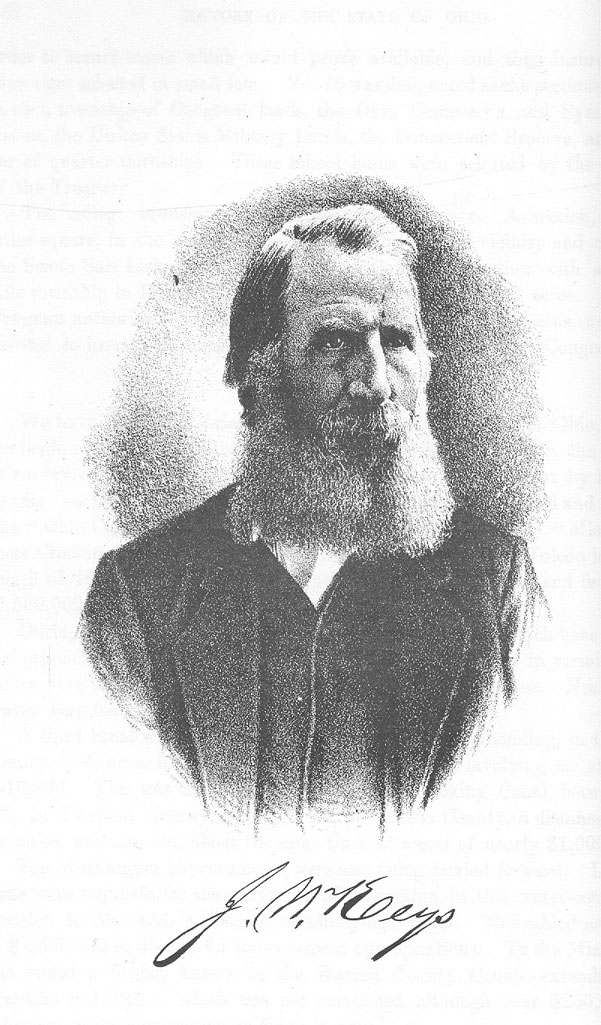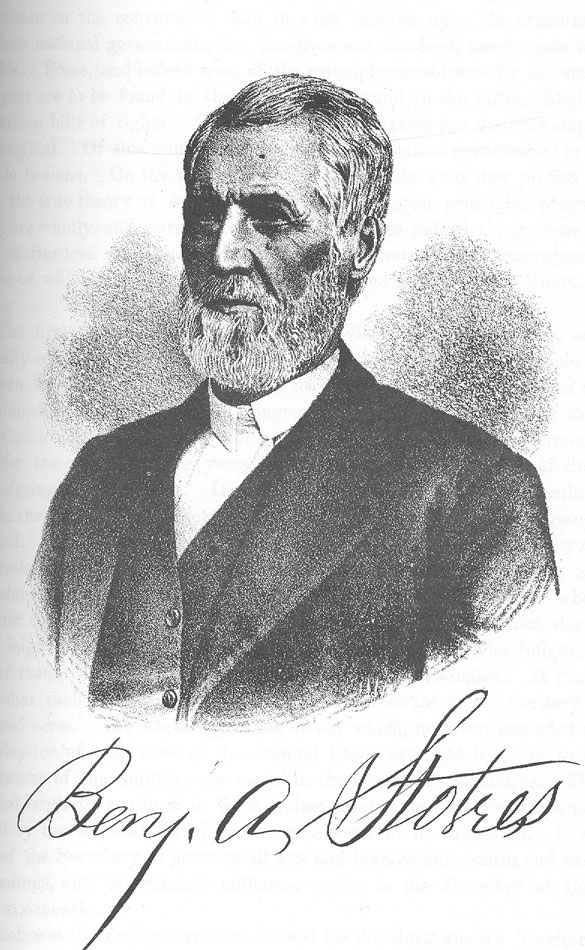PREFACE.
The writer of the following county history, fifteen years ago, while a law student and engaged in editorial work, began the collection and preservation of materials for the history of his native county. At that time he had no intention of publishing a county history, but he was impressed with the importance of authentic local histories, and was aware that the materials he collected would increase in interest and value with the advance of time. Without the aid of the historic data thus collected and preserved, the following sketch, imperfect as it is, would not have been written. There has never been any historical society or pioneer association engaged in the collection of the historic data of Warren County, and, before the writer began this work, much of the pioneer history of the county was irrevocably lost.
So numerous are the sources from which the author has drawn the following work that no attempt has been made to indicate them in foot-notes. He has faithfully aimed at accuracy, both in dates and narratives, but doubtless errors will be found. The materials for the local historian are found in sources widely scattered—in books, pamphlets, periodicals and newspaper files; in manuscripts, church records, court records and Justices' dockets; in local laws, the charters, manuals and minutes of societies; in private letters, journals and diaries, especially of intelligent observers; in funeral sermons, obituary notices and inscriptions on tombstones; in the memory of living persons, of what they have themselves witnessed, and, last and least valuable of all, tradition. Where they could not be supported by some record or cotemporaneous document, the writer has received traditional accounts with the utmost caution.
Interest in local annals has greatly increased in recent years. In several of the New England States statutes now authorize a tax for the publication of local histories and records. The joint resolution of Congress in 1876, recommending the preparation of a sketch of the history of each town and county to be preserved in the Library of Congress, gave an impetus to local historical studies. A praiseworthy enthusiasm has become widespread to cherish the memory of the pioneers and to collect all the incidents and narratives connected with the early settlements, but it would be better that all should sink into oblivion than that there should be recorded as truthful history the fabulous stories handed down by tradition, or the statements having a basis of fact, but distorted and exaggerated by that greatest enemy of authenticity—the love of the marvelous. In matters of doubtful authenticity, the writer has assumed as a guiding principle that the record of a false statement as the truth will be a greater evil than the loss of a true statement.
JOSIAH MORROW.






215 - HISTORY OF WARREN COUNTY.
CHAPTER I.
ORGANIZATION AND BOUNDARIES.
WARREN COUNTY was established by an act of the first General Assembly of the State of Ohio, passed March 24, 1803, and named at the same time in honor of the first great martyr in the cause of American independence. The act creating the county took effect May 1, 1803, and with this date the history of the county, as a civil division, begins.
When Ohio became a State, but nine counties had been formed within its limits by proclamation of the Territorial Governor, and one of the first duties of the first State Legislature, which met at Chillicothe March 1, 1803, was the creation of new counties. Out of the largo territory of Hamilton County, as it then existed, Warren, Butler and Montgomery Counties were formed by one act, and by the same act the county of Greene was formed out of Hamilton and Ross.
In the boundaries of Warren County, the mouth of the O'Baunon is the only point fixed by nature. The northern boundary of Clermont, which was a due east line from the mouth of the O'Bannon, had already been established, and was made the southern boundary of Warren, east of the Little Miami. The county, at its organization, extended eastward to the present site of Wilmington, and included no territory west of the Great Miami. In 1810, when Clinton County was formed, its western boundary was decreed to be so fixed as to leave to Warren a constitutional area of 400 square miles. On January 30, 1815, the territory of our county west of the Great Miami was detached from Butler and attached to Warren, and at the same time, eleven square miles of this county extending along its eastern border—being a narrow strip about half a mile in width—were attached to Clinton.
The territory thus formed into Warren County was made up of parts of three different tracts of lands, deriving their designations from the manner in Which they were transferred to the occupants from the Government—first, the officers Military Lands, including all of the county east of the Little Miami; in second, Symmes' Purchase, including that portion west of the Little Miami and south of an east-and-west line passing about a mile north of Lebanon; and third,,
Congress Lands, or lands transferred immediately to the occupants by the officers of the Government, comprising the remainder of the county.
HAMILTON COUNTY.
For a period of thirteen years subsequent to 1790, and for about eight years after the first settlement, Warren County, or that portion of it between the Miamis, formed a part of Hamilton County, with the seat of justice at Cincinnati. That portion of Warren west of the Great Miami, from 1790 to 1798,
216 - HISTORY OF WARREN COUNTY.
was a part of Knox County, with the seat of justice at Vincennes on the Wabash; from 1798 to 1803, a part of Hamilton; and from 1803 to 1815, a part of Butler. The part of Warren east of Little Miami seems to have been included in Hamilton County 1796 to 1803.
Hamilton County, the second county of the Northwest Territory, was formed by proclamation of Gov. Arthur St. Clair, January 2, 1790. It was originally bounded on the south by the Ohio; on the east, by the Little Miami; originally west, by the Great Miami ; and on the north, by a line drawn due east from the Standing Stone Forks or branch of the Great Miami The Standing Stone Fork or branch of the Great Miami is supposed to have been Loramie's Branch which flows into the Miami near the northern boundary line of Miami County. On August 15, 1796, the eastern boundary line of Hamilton County was altered, and declared to be a due north line from the lower Shawnee town on the Scioto River. On June 22, 1798, the western boundary of Hamilton County was declared to run with the Greenville treaty line from the Ohio River to Fort Recovery.
VIRGINIA COUNTIES.
But at still earlier dates, our territory had been made a part of political divisions called counties. During the Revolution, this region would have been marked on a map of the North American Colonies as a part of Virginia, whose extensive domain making her the mother of States as well as of Presidents, reached to the Mississippi. Out of this broad territory, vast counties were formed. The county of Kentucky included the whole of the present State of that name. In October, 1778, Virginia, by statute, declared that: "All the citizens of the commonwealth of Virginia, who are already settled or who shall hereafter settle on the western side of the Ohio, shall be included in a distinct county, which shall be called Illinois County." Our territory, then, once formed a part of the vast western county of Virginia called Illinois.
But, going back a few years further, we find this region included in a county of still more vast extent. South of the Natural Bridge, between the Blue Ridge and the Alleghanies, and intersected by the James River, is a county of Virginia, with Fincastle for its seat of justice, named Botetourt, in, honor of Norborne Berkeley, Lord Botetourt, a conspicuous actor in American colonial history, and Governor of Virginia. That county was established in 1769, and originally included our county within its limits. It was bounded on the east by the Blue Ridge, on the west by the Mississippi, and comprised Western Virginia, Ohio, Indiana, Illinois, Michigan, Wisconsin and Minnesota. Fincastle, then, as now, was the county seat.
The following curious provision is found in the act of Virginia creating Botetourt County:
And whereas, the people situated on the Mississippi, in the said county of Botetourt, will be very remote from the court house, and must necessarily become a separate county as soon as their numbers are sufficient—which probably will happen in a short time: Be it therefore enacted by the authority aforesaid (House of Burgesses) that the inhabitants of that part of the said county of Botetourt which lies on the said waters, shall be exempted from the payment of any levies to be laid by the said county court, for the purpose of building a court house and prison for said county.
BOUNDARIES OF WARREN COUNTY.
ACT OF MARCH 24, 1803.
SECTION 1.—That all that part of the county of Hamilton included within the following bounds, viz.: Beginning at the northeast corner of the county of Clermont, running: thence west with the line of said county to the Little Miami; thence up the same with the meanders thereof to the north boundary of the first tier of sections in the second entire range of townships in the Miami Purchase; thence west to the northeast corner of Section No. 7 in the third township of the aforesaid range; thence north to the Great Miami
HISTORY OF WARREN COUNTY - 217
thence up the same to the middle of the fifth range of townships; thence east to the Ross
county line; thence wrth same south to the place of beginning—shall compose one new county,
to be called and known by the name of Warren.
ACT OF JANUARY 30, 1815.
Ross SECTION 1.—That all that part of the county of Butler lying and being within the
first and second fractional townships in the fifth range a, and adjoining the south line of
Montgomery County, shall be and the same is hereby attached to and made part of the county of Warren.
Sec. 2. - That eleven square miles of the territory of the county of Warren and extended parallel to the said eastern boundary of Warren County, along the whole length of such eastern boundary from north to south, shall be and the same is hereby attached to and made a part of the County of Clinton.